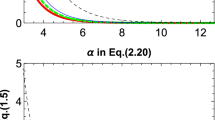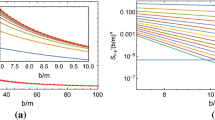Abstract
The bending angle of light is a central quantity in the theory of gravitational lensing. We develop an analytical perturbation framework for calculating the bending angle of light rays lensed by a Schwarzschild black hole. Using a perturbation parameter given in terms of the gravitational radius of the black hole and the light ray’s impact parameter, we determine an invariant series for the strong-deflection bending angle that extends beyond the standard logarithmic deflection term used in the literature. In the process, we discovered an improvement to the standard logarithmic deflection term. Our perturbation framework is also used to derive as a consistency check, the recently found weak deflection bending angle series. We also reformulate the latter series in terms of a more natural invariant perturbation parameter, one that smoothly transitions between the weak and strong deflection series. We then compare our invariant strong deflection bending-angle series with the numerically integrated exact formal bending angle expression, and find less than 1% discrepancy for light rays as far out as twice the critical impact parameter. The paper concludes by showing that the strong and weak deflection bending angle series together provide an approximation that is within 1% of the exact bending angle value for light rays traversing anywhere between the photon sphere and infinity.
Similar content being viewed by others
References
Petters A.O, Levine H. and Wambsganss J. (2001). Singularity Theory and Gravitational Lensing. Birkhauser, Boston
Schneider P., Ehlers J. and Falco E.E. (1992). Gravitational Lenses. Springer, Berlin
Kochanek C.S., Schneider P. and Wambsganss J. (2005). Gravitational Lensing: Strong, weak, and micro. In: Meylan, G., Jetzer, P., and North, P. (eds) Lecture Notes of the 33rd Saas-Fee Advanced Course, pp. Springer, Berlin
Keeton C.R. and Petters A.O. (2005). Phys. Rev. D 72: 104006
Keeton C.R. and Petters A.O. (2006). Phys. Rev. D 73: 044024
Keeton C.R. and Petters A.O. (2006). Phys. Rev. D 73: 104032
Gérard, J.-M., Pireaux, S.: gr-qc/9907034 (1999)
Bodener J. and Will C. (2003). Am. J. Phys. 71: 770
Sereno, M., De Luca, F.: astro-ph/0609435 (2006)
Virbhadra K.S. and Ellis G.F.R. (2000). Phys. Rev. D 62: 084003
Frittelli S., Kling T.P. and Newman E.T. (2000). Phys. Rev. D 61: 064021
Eiroa E.F., Romera G.E. and Torres D.F. (2002). Phys. Rev. D 66: 024010
Petters A.O. (2003). Mon. Not. R. Astron. Soc. 338: 457
Perlick V. (2004). Phys. Rev. D 69: 064017
Bozza V., Capozziello S., Iovane G. and Scarpetta G. (2001). Gen. Relativ. Gravit. 33: 1535
Bozza V. (2002). Phys. Rev. D. 66: 103001
Bozza V. (2003). Phys. Rev. D. 67: 103006
Bozza V. and Mancini L. (2004). Gen. Relativ. Gravit. 36: 435
Bozza, V., De Luca, F., Scarpetta, G., Serenom, M.: gr-qc/0507137 (2005)
Bozza V. and Mancini L. (2005). Astrophys. J. 627: 790
Amore, P., Cervantes, M., De Pace, A., Fernandez, F.M.: gr-qc/0610153v3 (2007)
Darwin, C.: Proc. R. Soc. London A249, 180 (1959); A263, 39 (1961).
Atkinson R.D. (1965). Astron. J. 70: 517
Luminet J.-P. (1979). Astron. Astrophys. 75: 228
Chandrasekhar, S.: The Mathematical Theory of Black Holes, Oxford (1992)
Ohanian H. (1987). Am. J. Phys. 55: 428
Byrd P.F. and Friedman M.D. (1971). Handbook of Elliptic Integrals for Engineers and Scientists. Springer, Heidelberg
Author information
Authors and Affiliations
Corresponding author
Rights and permissions
About this article
Cite this article
Iyer, S.V., Petters, A.O. Light’s bending angle due to black holes: from the photon sphere to infinity. Gen Relativ Gravit 39, 1563–1582 (2007). https://doi.org/10.1007/s10714-007-0481-8
Received:
Accepted:
Published:
Issue Date:
DOI: https://doi.org/10.1007/s10714-007-0481-8




